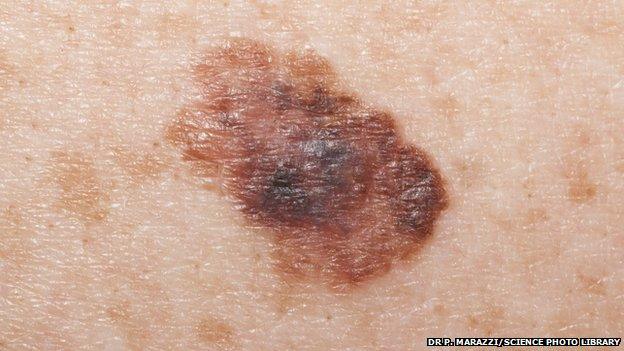Hospitals see rapid rise in skin cancer
- Published

In most cases, melanomas have an irregular shape and more than one colour. They may also be larger than normal moles and can sometimes be itchy or bleed
The number of people admitted to hospital for skin cancer treatment in England rose by nearly a third in five years, official figures show.
In 2007 there were 87,685 admissions, while in 2011 there were 123,808.
The data, gathered by researchers at Public Health England, does not include treatment in outpatient units or by GPs.
Experts say cheap foreign holidays and the fashion for having tanned skin are probably to blame for the increase.
The majority of the cancers treated were on the head and neck.
While skin cancers can be serious, they are also largely avoidable as excess sun exposure is the major cause.
The figures, which will be presented at the World Congress On Cancers Of The Skin, in Edinburgh later this week, show that admissions for both the most risky form of skin cancer - malignant melanoma - and other skin cancers are on the rise.
Between 2007 and 2011, hospitals in England saw a 30% increase in admissions for melanoma treatment and a 43% rise in non-melanoma skin cancer admissions.
Dermatologist Dr Walayat Hussain says the UK is experiencing "a tsunami of skin cancer"
The cost of this treatment - mostly for surgery to cut the tumours out - now stands at more than £95m a year.
Some patients were treated as day cases, but others had to stay in hospital.
More than 16,000 skin grafts and flaps were needed to treat the disease in 2011 alone.
Yet experts say the bulk of these skin cancer cases could have been avoided by better protection of the skin from the sun's harmful rays.
Although public awareness about the dangers of too much exposure to UV light has improved, many people still take risks and get burnt.
Sunburn doubles your chance of developing melanoma.
Johnathon Major, of the British Association of Dermatologists, said: "As holidays to sunny locations become cheaper and tanned skin remains a desirable fashion statement, we have seen an inevitable increase in skin cancer incidence rates and the associated health and financial burden they place on the nation."
Sarah Williams, senior health information officer at Cancer Research UK, said: "Changes to where patients are treated may have added to the size of this increase in hospital treatment for skin cancer, but it's worrying to see rising rates of a disease that could largely be prevented.
"Although it may seem that summer's over, September sun in the UK can still be strong enough to burn, especially for those who have sensitive skin.
"When the sun is strong, covering up with clothes and spending time in the shade are the best ways to protect your skin from sunburn and reduce the risk of skin cancer."

Mole or melanoma?
A good way to tell the difference between a normal mole and a melanoma is to use the ABCDE checklist:
Asymmetrical - melanomas have two very different halves and are an irregular shape
Border - unlike a normal mole, melanomas have a notched or ragged border
Colours - melanomas will be a mix of two or more colours
Diameter - unlike most moles, melanomas are larger than 6mm (0.25in)
Enlargement or evolution - a mole that changes characteristics and size over time is more likely to be a melanoma
Source: NHS Choices

- Published20 June 2014

- Published1 September 2014

- Published31 August 2014
